OUR Project
T60
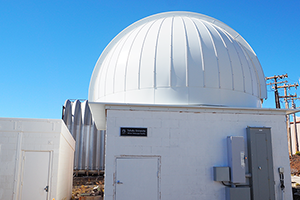
In September 2014, we opened the T60 observation facility, a telescope dedicated to observing planetary atmospheres. Located at the 3,000-m summit of Haleakalā on Maui, Hawai‘i, this site hosts a cluster of world-class facilities. In collaboration with the University of Hawai‘i, we operate the 60 cm optical telescope T60, equipped with three unique instruments for cutting-edge observations of Solar-System bodies and other targets.
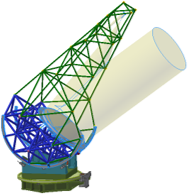
The PLANETS (Polarized Light from Atmospheres of Nearby Extra-Terrestrial Systems)telescope is a 1.8-meter off-axis Gregorian facility designed for high-dynamic-range imaging, spectroscopy, and polarimetry of bright astronomical sources and the faint structures in their vicinity, and is being advanced through international collaboration. The telescope’s design allows for precise optical performance and contrast enhancement, making it a valuable tool for a wide range of scientific investigations in stellar, planetary, and exoplanetary astrophysics.
IPRT
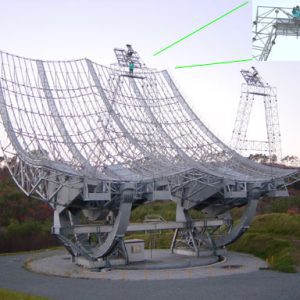
IPRT (Iitate Planetary Radio Telescope) is a large aperture radio telescope developed in 2001 to investigate temporal variations of synchrotron radiation emitted from Jupiter’s radiation belts. Continuous observations of Jupiter’s synchrotron radiation elucidate the acceleration and transport processes of radiation belt. In addition to Jupiter’s synchrotron radiation, IPRT monitors solar radio bursts and conducts pulsar observations. From solar radio burst observations, we aim to understand the radiation environment in the interplanetary medium. Recent project of IPRT includes Very Long Baseline Interferometry (VLBI) observations with the aim of participating in the Square Kilometre Array (SKA).
Aurora
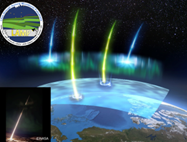
Pulsating aurora is one type of aurora which variates with a period of several seconds. Recently, it has been hypothesized that when the pulsating aurora occurs, high-energy electrons with energies of several hundred kiloelectron volts or more, called “killer electrons,” also precipitate at the same time. These “killer electrons” can penetrate to the middle atmosphere at low altitudes of tens of kilometers and may destroy the ozone.
We started the discussion with American researchers in 2015 and proposed the LAMP rocket experiment to NASA. PPARC was responsible for the development of the two onboard cameras to observe aurora from space. The rocket successfully launched and observed the pulsating aurora immediately after a significant auroral breakup from Poker Flat, Alaska, on March 5, 2022. This observation revealed a one-to-one correspondence between killer electrons and pulsating auroral emission precisely for the first time in the world.
Based on this achievement, we are now preparing for the next LAMP-2 rocket experiment, which is planned to enhance the linkage with ground-based radar and optical observations.
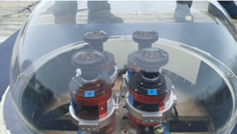
Multi-wavelength observations of ground-based all-sky cameras are important for understanding the morphology and other characteristics of the aurora. National Institute of Polar Research (NIPR) is conducting the Phase X Research (Aurora X Project: FY2022~27). In the polar cap region, direct interaction between the solar wind and the atmosphere occurs, resulting in electron and ion precipitation over a wide energy range from several hundred eV (solar wind) to MeV (SEP).
We developed 10 all-sky cameras for this project: four at Syowa Station starting in 2023, two each at Casey and Davis Stations of Australia, and two each at Dumont d’Urville and Concordia Stations of France and Italy in 2025. In addition, the Arctic Scandinavian cameras in 2024.
We also started low-latitude aurora at Iitate observatory of PPARC since 2024.
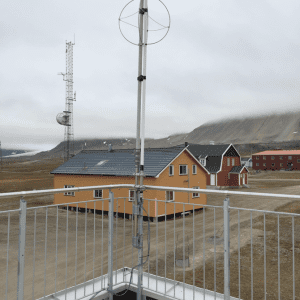
OCTAVES (Observation of CondiTion of ionized Atmosphere by VLF Experiment) is a VLF/LF ionosphere observation network that measures modification of electron density in the lower ionosphere. Low frequency (LF) and very low frequency (VLF) radio waves propagate between earth’s surface and lower edge of ionosphere (70-90km, approx.) at long distance.
As modification of the lower ionosphere causes changes in received signal amplitude and phase, LF/VLF radio observation is a useful probe to detect variation of electron density in the lower ionosphere.
Scientific targets of this network includes (1) Energetic particle precipitation from radiation belts, (2) Lightning effects on upper and middle atmospheres, (3) Solar X-ray flare and proton event effect on upper and middle atmospheres, (4) Effects of solar eclipse, atmospheric gravity waves, and sound wave on the lower ionosphere, and (5) Detection of gamma ray burst.
Space Probe Project
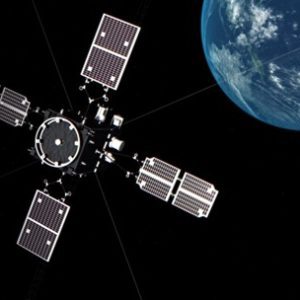
ARASE is developed by the Japan Aerospace Exploration Agency (JAXA) to explore “geospace”, the space around the Earth. It was launched in December 2016 to explore the radiation belt (Van Allen belt), a region around the Earth where high-energy particles are trapped by Earth’s magnetic field, and the electromagnetic waves and plasmas which involved in the acceleration and loss of radiation particles. Since the radiation belts can have impacts on human activities in space, ARASE aims to investigate the generation process of high-energy particles in space, as well as to promote space weather research to predict the space environment.
Tohoku University has been involved in the development of the Plasma Wave Experiment (PWE) onboard the satellite and the construction of a ground-based observation network to observe auroras and electromagnetic waves in cooperation with ARASE.
ISAS Arase project
Nagoya University ERG science
Illustration by JAXA
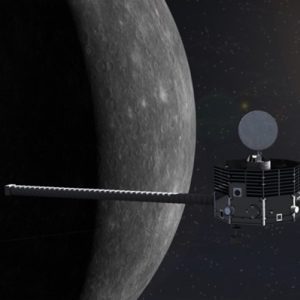
“Mio” is a Mercury exploration spacecraft developed jointly by Japan (JAXA) and Europe (ESA) as part of the BepiColombo mission, launched in 2018. Its purpose is to investigate Mercury, the planet closest to the Sun. Mio is designed to study Mercury’s magnetic field, magnetosphere, and interaction with the solar wind in detail. Due to its proximity to the Sun, MIO will conduct observations in a hot and harsh environment. It is hoped that elucidating Mercury’s environment and origin will provide clues to understanding the origins of the solar system.
Tohoku University is involved in the development of the Plasma Wave Investigation (PWI) and the Mercury Sodium Atmosphere Spectral Imager (MSASI).
ISAS Mio project page
Illustration by JAXA
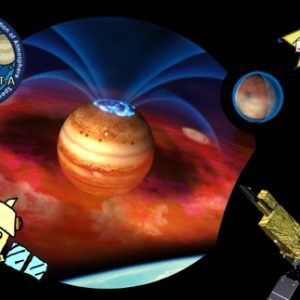
The Hisaki satellite is equipped with an extreme ultraviolet spectrograph and is the world’s first space telescope designed for planetary observations. By observing the time variable aspects of atmospheres of terrestrial planets such as Venus and Mars, and hot plasma in the Jovian magnetosphere, Hisaki provided opportunity to study the atmospheric evolution of terrestrial planets in the Solar System and the origin of mass and energy in Jupiter’s magnetospheric plasma. The Hisaki satellite was launched on 14 September 2013. Aft¬er more than 10 years of continuous extreme ultraviolet spectroscopic observations, the satellite was decommissioned on 8 December 2023.
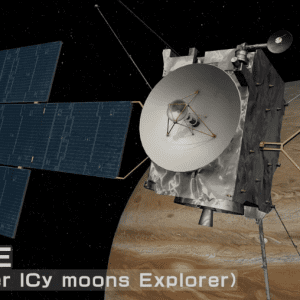
JUICE (JUpiter ICy moons Explorer) is a spacecraft developed by the European Space Agency (ESA) to explore Jupiter and its icy moons. It launched in April 2023. The main objectives of JUICE are to investigate the atmosphere and magnetosphere of the largest planet in the solar system, as well as icy moons Ganymede, Europa, and Callisto, focusing on their internal oceans, icy crusts, and potential habitability.
JUICE carries over 10 scientific instruments, one of which is the RPWI (Radio and Plasma Wave Investigation), designed to study plasma environments and electromagnetic waves around Jupiter and its moons. One of key component of RPWI, the High Frequency (HF) receiver, was developed by Tohoku University in Japan. RPWI will investigate the structure of Jupiter’s auroral radio waves, the ionosphere and subsurface structure of the satellites. JUICE is expected to arrive at Jupiter in the early 2030s and begin long-term observations that could offer new insights into the possibility of life in the outer solar system.
ISAS JUICE project
Illustration by JAXA
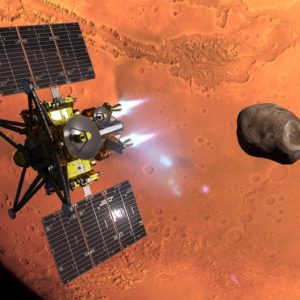
MMX (Martian Moons eXploration) is a mission led by JAXA (Japan Aerospace Exploration Agency) to explore Mars’ two moons, Phobos and Deimos. Scheduled for launch in 2026 and return in 2031, MMX aims to reveal the origins of the moons by collecting samples from Phobos and bringing them back to Earth.
MMX is equipped with several scientific instruments, one of which is the MMX Infrared Spectrometer (MIRS), which will analyze infrared radiation emitted from the surface of the satellite to determine their composition, such as minerals and water ice as well as to observe the Martian atmosphere.
Tohoku University is involved in the development of MIRS and is developing analytical methods to investigate Martian meteorological phenomena from infrared spectroscopic data from MIRS.
ISAS MMX project
Illustration by JAXA
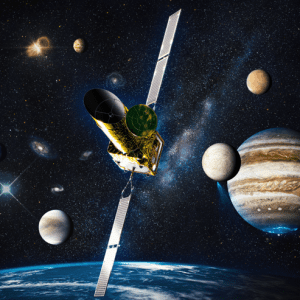
The LAPYUTA mission aims “to explore the habitable environment of the Universe” and “to understand the origin of matter and space in the Universe”. From unresolved issues related to the two goals, we selected four scientific objectives to be addressed in the 2030s: (1) habitable environments of solar system bodies, (2) atmospheres of exoplanets, (3) galaxy formation, and (4) the origin of heavy elements, which will be realized by the ultraviolet space telescope. LAPYUTA was selected as one of candidates of JAXA’s M-class mission, and aims to realize a high-resolution, high-sensitivity ultraviolet telescope by optimizing the performance requirements to the science objectives.

FACTORS is a future formation flight satellite mission at an altitude range up to thousands of kilometers of Earth’s polar regions. The space environment in this region is characterized by inter-regional connections that manifest themselves on diverse temporal and spatial scales, as exemplified by the small-scale complex structures of auroras. This environment involves the acceleration and transport of space matter, the excitation and propagation of waves associated with these processes, and the formation and interaction of electric field and current structures. These phenomena are considered fundamental and universal mechanisms for the formation of magnetospheres and atmospheric evolution in magnetized planetary systems.
FACTORS will consist of instruments measuring magnetic field, electric field, and plasma particles, as well as auroral cameras developed by PPARC. Utilizing the experience gained from cameras installed on the Reimei satellite and LAMP rockets, these cameras plan to observe the fine structures of auroras at two wavelengths, visible and ultraviolet.
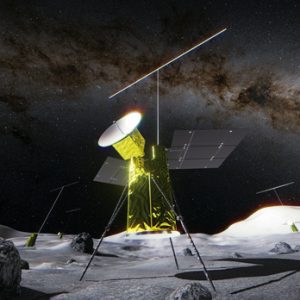
TSUKUYOMI is a low frequency radio telescope that deploys a number of radio antenna on the Moon to observe radio waves in the 1-50 MHz frequency range which includes frequencies that are shielded by the Earth’s ionosphere and cannot be observed on the Earth. Goals of this project is to detect signals from neutral hydrogen lines (radio waves with a frequency of 1.42 GHz) in the ‘dark ages’ before the formation of stars and galaxies in the Universe and to observe stellar radiation and auroral radio emission in exoplanetary system. The first prototype will be ready in the 2020s.By the end of the 2030s, the project aims to deploy more than 10 radio antennas on the Moon.

